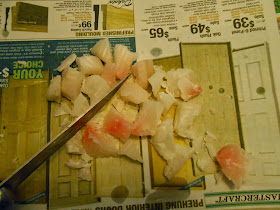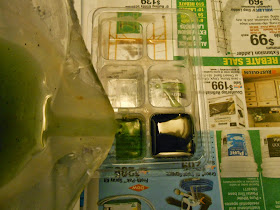Feeding birds has always been a hobby of mine-I have been doing it for years now and nothing entertains me more than watching the birds feeding. I get rewarded with their antics and their activities and even when I am crabby they make me smile. And nothing tops a visit from a bird that is uncommon in my area. Bird feeding is a rewarding hobby and if you follow these tips it will be rewarding for your feathered friends.
1. Place feeders in different areas of your yard and garden-this will give all the birds an opportunity to eat not just the "bully" birds like Jays and Starlings.
2. Provide water year round. I even provide water in winter with this heated birdbath. The birds share it with the other animals that use it.
 |
| Heated birdbath |
3. Be consistent if you wish to keep having them return. Don't let your feeders remain empty for a long time between fillings
4. Have a variety of feeder types available. I have very hungry squirrels in my yard so I have feeders that are "squirrel proof". There are many types available including hanging, platform, tube, suet, and "sock" feeders.
 |
| Hanging squirrel resistant feeders |
 |
| Squirrel resistant feeder on a pole |
 |
| Platform feeder slightly off of the ground |
5. Don't forget the ground feeders! Birds like Juncos and Turtle Doves prefer to feed on the ground-I usually just throw some down for them under the feeder. I also do this to keep the squirrels from trying to get at the other feeders. It usually helps:-))
 |
| Birdseed for ground feeders |
6. When choosing a birdseed or a mix don't waste your money on "cheap" birdseed or birdseed that contains a lot of fillers especially
Milo and wheat. Very few birds will eat it unless they are starving and it will end up growing under your feeder. Look at the ingredients on the bag:
 |
| Milo should not be the first ingredient in birdseed |
 |
| This birdseed has a good mix of ingredients-notice no milo |
 |
| This birdseed mix is good for Finches-notice no milo |
Don't buy "flavored" birdseed-it is usually artificial and is unnecessary to attract the birds. I have accidentally purchased the "berry" flavored and it made no difference. I really don't think they care.
Another waste of money is safflower-it is expensive and I have never had any of my birds prefer it. If you have an issue with squirrels your best bet is with a squirrel proof feeder. If you want the best all-around bird seed choose black oil sunflower. It appeals to the widest variety of birds including Woodpeckers, Finches, Cardinals, Titmice and Chickadees. You can usually find it on sale and it can be cheaper than most of the mixes.
 |
| 50 lb bag of Black Oil sunflower seeds |
Other foods you can provide: suet, mealy worms or bugs, peanuts (unsalted), peanut butter and whole corn.
Do not feed your birds processed foods such as white bread, cakes, donuts, etc. These contain additives and chemicals that aren't good for us let alone wildlife. It will also attract unwanted pests like rats and mice and also less desirable birds such as crows and starlings to your yard.
7. Provide cover for them to fly into to escape potential predators. Shrubs and trees will provide the safety they need to feel better.
8. Leave seed heads of some of your plants and flowers standing in the Fall and Winter. Plants like Agastache, Rudbeckia, and Echinacea provide another food option for the birds. You can also plant shrubs and trees that provide nuts and berries to provide food for them.
9. Keep it clean! Keep your feeders and birdbaths clean to help prevent the spread of diseases that might potentially make the birds sick. Also throw away any seed that has gotten moldy from being wet. Do not leave it in the feeder. Clean up around the bottom of your feeders to remove the hulls from the seed and occasionally move your feeders to keep the area below clean for the ground feeders. Here are a few pics of my visitors:
10. Enjoy them! I hang a few feeders outside my windows so I can watch them feed especially in the morning when I am drinking my coffee. It is better than TV.
 |
| Northern Cardinal at feeder |
 |
| Turtle Dove |
 |
| Turtle Dove junco and Sparrow |
 |
| Blue Jay |
If you have any questions, comments or suggestions feel free to leave them below.
Until next time-Happy Planting!
Rhonda























































